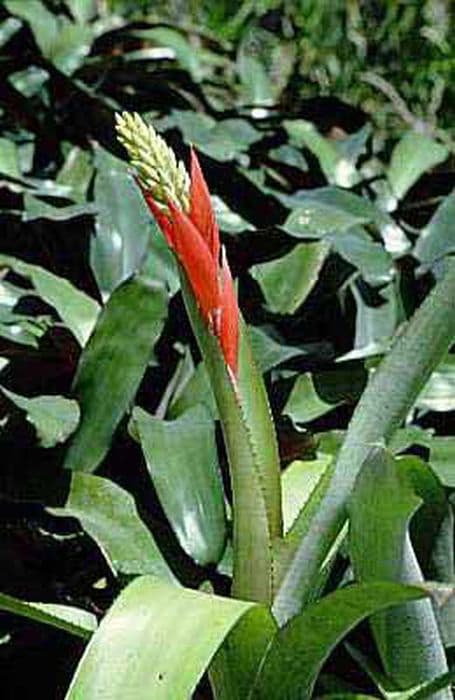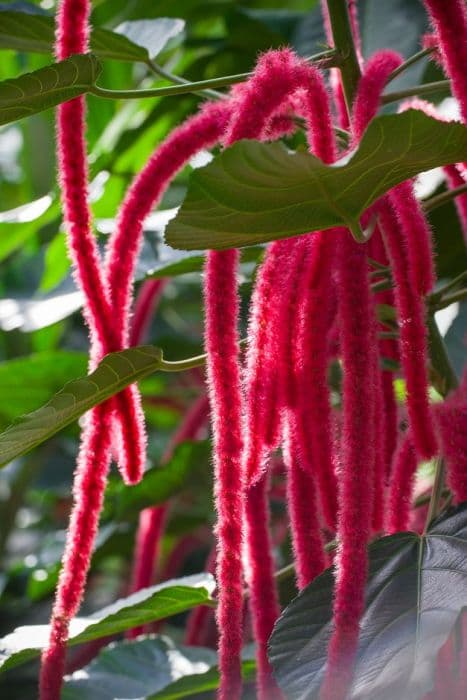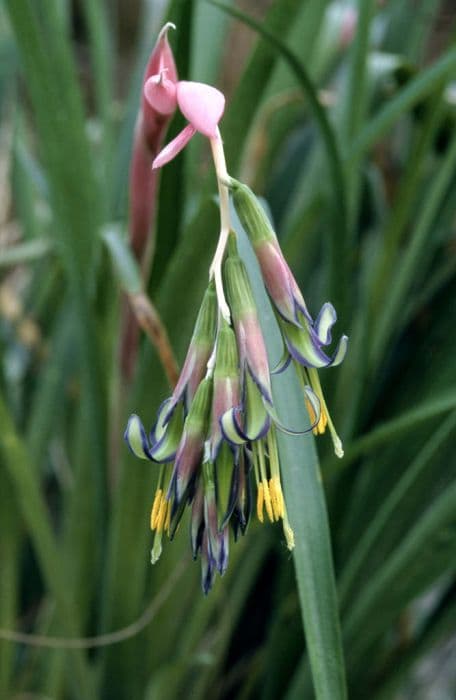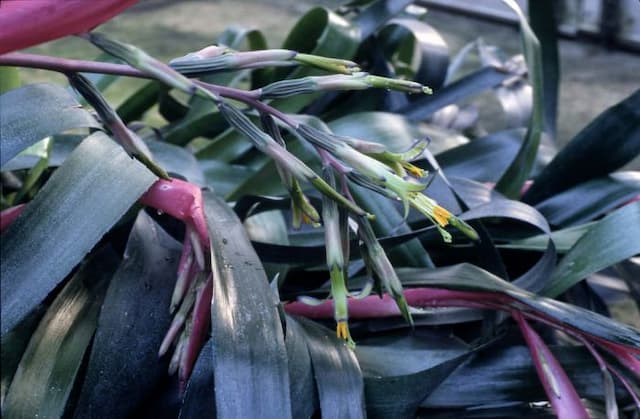Brazilian Vase Plant Aechmea nudicaulis

ABOUT
The Aechmea nudicaulis, commonly known as the Aechmea, is a vibrant and striking plant that is notable for its rosette of stiff, lance-shaped leaves. These leaves can vary in color, often featuring green with shades of red, especially when exposed to bright light. The leaf edges are typically lined with small, sharp spines that can be quite pointed to the touch. The Aechmea's most distinguishable feature is its flower spike. The spike emerges from the center of the rosette, carrying bracts that are brightly colored in hues of red or yellow, which stand out against the foliage. These bracts are arranged in a flattened, sword-like shape and are very conspicuous. Atop these bracts, small tubular flowers appear, which are usually purple or blue, adding to the plant's attractive display. The Aechmea blooms infrequently, often producing flowers in a cycle that spans several years. After blooming, the plant may produce offsets, which are young plants that grow at the base of the parent, eventually leading to clumps of Aechmeas if they are not separated. The overall appearance of the Aechmea nudicaulis is exotic and tropical, giving it a flair that is well-suited for bright indoor spaces or warm outdoor garden settings. It is a popular ornamental plant known for its long-lasting flower spike and its ease of care in the right conditions.
About this plant
 Names
NamesFamily
Bromeliaceae
Synonyms
Orlandiana, Silver Vase Plant
Common names
Aechmea fulgens var. nudicaulis, Billbergia nudicaulis, Hoplophytum nudicaule, Quesnelia nudicaulis, Tillandsia nudicaulis.
 Toxicity
ToxicityTo humans
The Aechmea nudicaulis, commonly known as the "Bromeliad," is not considered toxic to humans. Generally, there are no harmful consequences associated with touching or ingesting parts of this plant.
To pets
The Aechmea nudicaulis, known as the "Bromeliad," is also not considered toxic to pets. It is not known to cause any harmful effects if pets come into contact with or ingest this plant.
 Characteristics
CharacteristicsLife cycle
Perennials
Foliage type
Evergreen
Color of leaves
Varies
Flower color
Varies
Height
1-2 feet (30-60 cm)
Spread
1-2 feet (30-60 cm)
Plant type
Bromeliad
Hardiness zones
10
Native area
Brazil
Benefits
 General Benefits
General Benefits- Ornamental Value: Aechmea nudicaulis, commonly known as the Zebra Plant, provides striking visual appeal with its bright flowers and distinctive striped foliage that can add aesthetic value to gardens and indoor spaces.
- Low Maintenance: This plant is known for being particularly easy to care for, which makes it ideal for both inexperienced gardeners and those who do not have a lot of time for plant maintenance.
- Drought Resistance: It has a good tolerance for drought conditions, which can be beneficial in areas that experience water scarcity or for gardeners who prefer plants that do not require frequent watering.
- Suitable for Containers: The Zebra Plant adapts well to container growth, making it a versatile choice for decorating patios, balconies, and indoor spaces where garden soil is not available.
- Long Blooming: With its long-lasting blooms, it provides extended periods of visual enjoyment, as the flowers often remain attractive for several weeks or even months.
- Habitat for Wildlife: When planted outdoors, Aechmea nudicaulis can attract pollinators such as hummingbirds, providing a valuable nectar source for them.
- Adaptability: The plant is fairly adaptable to a range of light conditions, allowing it to thrive in various lighting environments, from bright indirect light to shaded areas.
 Medical Properties
Medical PropertiesThis plant is not used for medical purposes.
 Air-purifying Qualities
Air-purifying QualitiesThis plant is not specifically known for air purifying qualities.
 Other Uses
Other Uses- Aechmea nudicaulis, commonly known as the Silver Vase Plant, can be used as a living water container. The central cup-like part of the plant holds water, providing a source of hydration for small creatures or could be used for emergency drinking water after proper purification.
- The stiff, colorful leaves of the Silver Vase Plant are sometimes used in floral arrangements to add an exotic and tropical feel to bouquets or as a standalone centerpiece.
- Silver Vase Plant can serve as a habitat for small epiphytic plants and mosses that can take root on its leaves, forming a mini-ecosystem.
- In arts and crafts, the unique form and patterned foliage of the Silver Vase Plant is often used as a natural inspiration for designs in textiles and home decor items.
- This plant is used in educational settings to teach about bromeliad physiology and the water-holding structures unique to this group of plants.
- Enthusiasts of terrarium making employ the Silver Vase Plant as a striking feature due to its minimal soil requirements and interesting shape.
- The Silver Vase Plant's water-filled rosette can also be used as a natural dye holder for fabric or paper dyeing projects, where different colors of dyes could be poured in and used directly.
- The reflective properties of its foliage make the Silver Vase Plant a candidate for light-themed garden designs, as it can create dramatic lighting effects when positioned thoughtfully.
- Biologists might utilize this plant as part of a study on water storage adaptations in plants or how its structure influences the microhabitat around it.
- Its sturdy leaves and rosette formation can be used as a natural mold or impression material in arts, to create plaster or cement casts with interesting textures for decorative objects.
Interesting Facts
 Feng Shui
Feng ShuiThe Aechmea nudicaulis is not used in Feng Shui practice.
 Zodiac Sign Compitability
Zodiac Sign CompitabilityThe Aechmea nudicaulis is not used in astrology practice.
 Plant Symbolism
Plant Symbolism- Resilience: Aechmea nudicaulis, commonly known as the "Zebra Plant," often symbolizes resilience due to its ability to thrive under varying light conditions and less-than-ideal care, reflecting an adaptability to life's challenges.
- Protection: The Zebra Plant's sturdy leaves and form can be taken to represent protection, suggesting a safe haven or shelter from adversity.
- Longevity: This plant is known for its long-lasting flowers and slow-growing nature, making it a symbol of longevity and endurance over time.
- Unique Beauty: With its striking striped leaves and bright inflorescences, the Zebra Plant signifies unique beauty, reminding us to celebrate our own individuality and the diverse beauty in the world.
 Water
WaterZebra Plant needs consistent moisture but should not be overwatered. It's best to water this plant when the top inch of soil feels dry. You should aim to water approximately every 7-10 days, providing enough water so that it runs through the drainage holes—about 1/4 to 1/2 gallon depending on pot size and indoor conditions. Allow excess water to drain away, and never let the pot sit in water as this can lead to root rot. During the winter months, you can reduce watering frequency as the plant's growth slows down.
 Light
LightZebra Plant thrives best in bright, indirect light. It should be placed in a spot where it receives natural sunlight but is shielded from intense midday rays, such as near an east or north-facing window. Direct sunlight can scorch its leaves, while too little light can cause leggy growth and a lack of vibrant leaf coloration.
 Temperature
TemperatureThe Zebra Plant prefers warm temperatures ranging from 60 to 80 degrees Fahrenheit. It can survive in temperatures as low as 40 degrees Fahrenheit, but growth may be stunted. To promote its health and flowering, keep the plant away from cold drafts and sudden temperature changes.
 Pruning
PruningPruning your Zebra Plant is necessary to remove dead or dying leaves, to maintain its shape, and to encourage healthier, denser growth. The best time for pruning is in the spring or early summer when the plant is entering its active growth phase. Prune sparingly, and always use clean, sharp scissors or pruning shears to make precise cuts without damaging the plant.
 Cleaning
CleaningAs needed
 Soil
SoilZebra Plant thrives in well-draining, loose orchid or bromeliad mix with a slightly acidic to neutral pH of 5.5 to 7.0. A mixture of two parts peat, one part perlite, and one part pine bark is often recommended.
 Repotting
RepottingZebra Plant should be repotted every 2-3 years or when the potting mix breaks down, as fresh soil provides nutrients and avoids waterlogging.
 Humidity & Misting
Humidity & MistingZebra Plant requires high humidity levels, preferably between 60% to 80%, to mimic its native tropical habitat.
 Suitable locations
Suitable locationsIndoor
Place Zebra Plant in bright, indirect light and maintain high humidity indoors.
Outdoor
Grow Zebra Plant in dappled shade, protect from cold, ensure high humidity.
Hardiness zone
10-11 USDA
 Life cycle
Life cycleAechmea nudicaulis, commonly known as the Orangetip Aechmea, begins its life cycle when a seed germinates in a suitable tropical or subtropical habitat, often in the canopy of trees as an epiphyte. Upon germination, the seedling develops into a juvenile plant with characteristic strap-shaped, spiny-edged leaves in a rosette formation that collects water and nutrients. Over time, the rosette matures and the plant produces a long-lasting flower spike with vibrant orange bracts and yellow flowers that attract pollinators. After pollination, seeds are produced and dispersed, and the cycle may start anew, while the mother plant starts to decline. Simultaneously, vegetative offshoots known as "pups" form at the base of the plant, which will grow into new individuals as the original plant completes its life cycle. The main plant typically dies after flowering and fruiting, with the pups taking over to continue the growth cycle.
 Propogation
PropogationPropogation time
Spring-Early Summer
Propogation: Aechmea nudicaulis, commonly known as the "Canistropsis Billbergioides," can be propagated mainly through the removal and planting of offsets, also known as pups. This method is favored because it's quite straightforward and effective for expanding your collection of these bromeliad plants. The ideal time to propagate is during the warm growing season, typically in late spring or early summer. Once the pups are about one-third the size of the mother plant and have a few roots, they can be carefully removed by twisting and pulling gently. After separation, the offsets should be allowed to dry for a day to form a callous over the wound, thereby reducing the risk of rot. These pups can then be planted in a well-draining potting mix, kept moist, and provided with bright, indirect light. This encourages them to root and grow independently, continuing the cycle of the plant's life.









